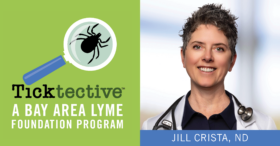Bay Area Lyme Quick Bites Series
“I think I prevented a lot of chronic Lyme cases by doing adequate early treatment. But I had a subset of patients who just were not getting better. These cases had either a current or a past exposure to mold.”
– Jill Crista, ND
In this latest episode of Ticktective™, our host, Dana Parish, talks with Dr. Jill Crista, a leading expert on the diagnosis and treatment of toxic mold exposure and illness. Dr. Crista started her practice in southern Wisconsin, which is often in the top five states for Lyme disease cases, even though Lyme is often thought of as a Northeast issue.
Click here to watch or listen now.
Parish and Crista discuss the complex nature of mold toxicity, including its impact on the immune system, the brain, and various organ systems. Crista emphasizes the importance of identifying the underlying causes of mold exposure, such as water damage and poor indoor air quality, rather than just addressing the symptoms.
Crista outlines a comprehensive approach to mold illness treatment, including the use of specific nutrients, binders, and antifungal agents to support detoxification and restore overall health. She also highlights the need for personalized testing and treatment protocols, as each individual’s response to mold exposure can vary significantly. Topics addressed include:
- The importance of early treatment and diagnosis of mold exposure to prevent chronic illness.
- Differences between Lyme disease and mold illness, including unique symptoms like tinnitus, vision changes, and pelvic pain.
- The immune-suppressive effects of mold and mycotoxins, and how they can reactivate other infections like Lyme.
- The challenge of testing and diagnosing mold exposure due to a lack of human clinical trials on mycotoxins.
- Strategies for detoxification and binders to help remove mycotoxins from the body.
- Nutritional supplements and herbs that can help support mitochondrial function, regulate bile flow, and protect against mycotoxin damage.
- The impact of mold exposure on hormones, weight, hair loss, and mental/cognitive function.
- Recommendations for finding a mold-literate doctor and accessing resources and support.
“The number one part of treatment is to get out of the mold exposure. 50% of people who leave that building get better.”
– Jill Crista, ND
Dr. Crista highlights the challenges of Lyme disease—its prevalence in certain regions, its complexity, the need for early treatment, and its ability to mimic other conditions. Her journey of becoming “Lyme literate” allowed her to better identify and treat Lyme and tick-borne diseases in her patients. She outlines the connection between mold exposure and Lyme disease, hormonal imbalances, and neurological issues, such as memory problems and dementia. She also provides practical tips for addressing these complex health challenges and emphasizes the importance of working with a healthcare provider who is knowledgeable about mold-related illness.
Jill Crista earned her Naturopathic Doctor Degree with Honors from the National University of Naturopathic Medicine in Portland, OR, in 2003. She is certified in IV Nutrient Therapy, including advanced training in Heavy Metal Toxicology and Oncology through International IV Nutrient Therapy. In 2012, she completed the Physician Training Program with the International Lyme & Associated Diseases Society.
This blog is part of our BAL Quick Bites series. If you require a copy of this article in a bigger typeface and/or double-spaced layout, contact us here. Bay Area Lyme Foundation provides reliable, fact-based information about Lyme and tick-borne diseases so that prevention and the importance of early treatment are common knowledge. For more information about Bay Area Lyme, including our research and prevention programs, go to www.bayarealyme.org.
